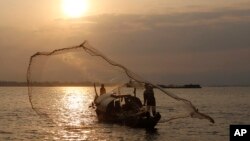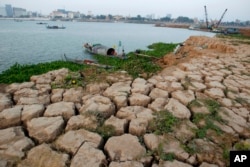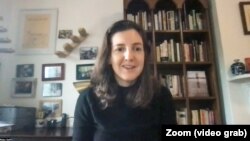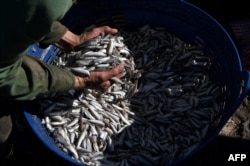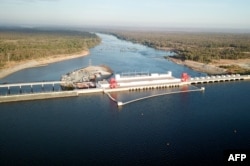New York/Phnom Penh —Editor's Note: The Tonle Sap Lake is one of the world’s richest inland fisheries. The lake is connected to the Mekong River through a tributary, which switches course twice a year and alternates between feeding the lake or draining it. At its peak, the Tonle Sap expands six times its dry-season size. This unique ecosystem has sustained fishing and paddy farming by millions of people since ancient times, but is now in severe crisis. A new book by American journalist Abby Seiff, titled “Troubling the Water: A Dying Lake and A Vanishing World in Cambodia,” tells of Cambodians’ deep connection with the lake and the threats posed by local overfishing, Mekong River dams and climate change. VOA Khmer spoke with Seiff, who also spent years working as a reporter in Cambodia. This interview has been edited for brevity and clarity.
VOA Khmer: You have been reporting on Cambodia as a journalist [and then] you primarily focused on politics and foreign affairs. Why did you become interested in the Tonle Sap Lake and [Mekong] River issues, and what that led you to write a book about it?
Seiff: I first became interested in this, I think, in 2016. There was a terrible drought in Cambodia at that time and there were even forest fires around the lake. So, I went up to the lake with photographer Nicholas Axelrod… We spent about a week there, talking to all of these fishing families along the lake. It was really interesting because it was clear that the situation wasn't just because of the drought and because of the forest fires. But that people were seeing really low [fish] catches and that this seemed to be worsening a lot in recent years. At that time, local media was reporting on this because of the hydropower dams, climate change and overfishing. And so I became quite interested in that whole situation…
But then, I was also interested in the historical situation at the lake. What was great about those interviews, as people talked about their memories of 10 or 20 years ago, [it became clear] how abundant the fish was then and how quickly that had changed. And then I was also looking at historical accounts from French colonialism, and even Zhou Daguan, the Chinese emissary in the 1200s. I loved those because they were describing the same lake, but it was just so abundant in fish and it was so overwhelming. Between those two things, I got interested in the bigger situation facing the Tonle Sap and I thought maybe this could be interesting to write a book about.
VOA Khmer: You have given an illustration of what the Tonle Sap Lake and the Mekong River centuries ago looked like by citing reports, essays, journals and books written by foreign explorers and visitors to Cambodia. What makes this ‘Great Lake’ and the river so unique and attractive to anyone who sees them?
Seiff: Anyone who sees it, when you read these old texts, is especially in awe of it. And to me, the thing that makes it really unique is the kind of the heartbeat of the lake… As we know, the lake expands up to six times its dry-season size. So, then we see things like the flooded forests and flooded villages that allow fish to migrate thousands of miles, especially fish like the Mekong Giant Catfish. And it, of course, allows [the abundant small fish] Trey Riel to come down the river [and into the lake]. It creates the really unique thing about the lake. That's what makes it so prodigious, what makes it such a great fishery and a really good floodplain. And all the paddy fields around the lake are fed with this really rich silt that's coming from upstream and moving throughout the lake.
That's what has allowed cultures to really thrive along there, especially the Khmer culture… From a social, cultural perspective, if we look at something like Water Festival—which is celebrating the [tributary] river reversing its course—this is important in culture, too. So to me, all of these things come together. It makes the lake really unique.
VOA Khmer: Could you tell us what happened to the Tonle Sap Lake during your coverage, starting from 2016 through the time when you finished the book?
Seiff: Even though 2016 was a very bad drought, in 2017 things sort of went back to normal and people were able to catch the same amount of fish they had a few years earlier. But what we saw in the next few years is just these historic lows in the Mekong River. I'm sure you remember this. I think it was in 2019, that there was the lowest level that happened in 100 years. And in Thailand, there was a whole dam reservoir that dried up and there was a temple that emerged. And in Laos and Cambodia, crops were really suffering. And in Vietnam’s Mekong Delta, of course, where the [Mekong’s] freshwater pushes out the saltwater, that kind of stopped happening. And so, all these crops were destroyed by salt water… It seemed like year after year, the water level was extremely low…
[The change] has been rapid, particularly if you're looking at water levels. The new [Mekong River Commission] president gave a speech last week and I think he said Mekong water levels are now at 50 percent of what they were before annually. So, this is like a totally changed hydrology. [Editor’s note: the Mekong River Commission is a regional river management body.]
VOA Khmer: Is the lake now gradually dying, like in the title of the book?
Seiff: I try to not be too pessimistic and I think there are reasons to be hopeful. If things come together well and if [Mekong River] countries can work together, if China can be more helpful in releasing water [from upstream dams], this will all help. But the problem for the Tonle Sap Lake is that double river reversal. As soon as you have dams, it's impossible for that to continue in the same way.
VOA Khmer: When you travel around Tonle Sap you hear the same stories from people living there: Less fish, a lot of debt. The water comes late and goes back too soon. If they move to the land and leave the water altogether, will their lives be better and can their families survive?
Seiff: People are in terrible debt because they can't catch as much fish as they need—not even to eat, [let alone] just to support themselves by selling fish. A lot of people, when you talk to them they say: “We want to move to land. Can the government give us land?” And in some in some places like in Kampong Chhnang [Province], there's been an effort to move some of the floating villages to land. I think, to social land concessions. That could help in some ways. But as you've seen, farmers in Cambodia really are suffering, too. The issues with drought and climate change don't just affect the lake. They affect crops and they affect the land. So, I think when fishers talk about land, there's a little bit of idealism. I don't know if they will be better off on the land. But I do think what's important is that people have a chance to diversify their income… To me, it seems like that's the only way forward.
VOA Khmer: Are there any other solutions or initiatives you have noticed that could save the lake? Or has the situation passed the point of no return?
Seiff: No, I think there are initiatives. I do think it's good if Prime Minister Hun Sen is seeing the importance of the lake and does want to protect it [by announcing government action]. A lot of this will have to come from the top levels. So, more enforcement [against illegal fishing and deforestation] would be great, but it's just as important as on whom the enforcement is focused. I don't know enough about the science behind the idea of widening the river [that connects the lake with the Mekong River]. I just hope that any discussions about changing the river's natural state are done with scientists and people with the technical know-how. But I think discussions like that show that it's a government priority. And if it truly is a government priority, that can be really helpful.
A couple of years ago, Cambodia also said it was going to have a moratorium on mainstream dams on the Mekong. That's great and very important and commendable. I would hope they would also stop pursuing [Mekong] tributary dams too, because those can be as damaging as mainstream dams.…
Lastly, China does have a lot of power. But China has also shown that it's open to working with Lower Mekong countries to release water [from upstream dams] in a way that will be helpful to Lower Mekong countries. And that's fantastic. If China does that, it's a sacrifice of sorts because that's water that would be giving [China] electricity. So if these discussions are happening and if there's that type of geopolitical will, that will be really important to help the Mekong. And it’s not just China. But I think the Lower Mekong countries as a whole have to work together a lot more and have to be on the same page. It's not great that Vietnam and Cambodia are really against having these dams in Laos, and then Laos still will go ahead and build them. There are definitely things that can be done at every level—regional and local—to help the situation there.
A lot could also be done to help the fishers, whether that's social support, debt forgiveness, education and vocational training and things that will give them other opportunities. So, anything that can be done to raise their situation a little bit can go far. I think there are concrete things that can be done. Even if it can't fix the flood-pulse system, it can help the situation on the lake a lot.




